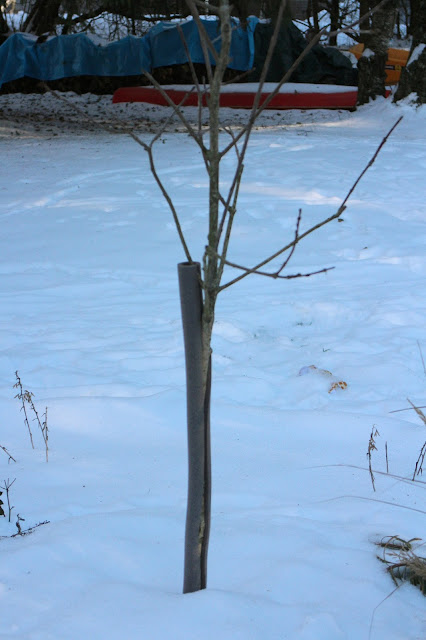PREPPING FOR WINTER ... A LITTLE LATE
I never really showed you some of what happens here in the winter when it comes to the garden. Winter brings a couple of serious challenges: protecting plants from the freeze/thaw cycle and protecting plants from hungry animals.
A lot of people think that it's the cold that is most harmful to plants, but really it's the continual cycle of freezing and thawing that does them in. If it would just freeze in late November, get a nice thick blanket of snow in December and then stay like that until it melted in March, most plants would be quite content. But that's rarely what happens, and it's even more rare these days when temperatures seem to fluctuate wildly. (It will be over 40 degrees tomorrow up here in southeastern Wisconsin, for instance.)
So some plants need some insulation, mostly at the roots. The best way to manage this is to give the root zone a good mounding of mulch (I love chopped up leaf mulch for this) very late in the season (like late November in our parts). But if you're like me, you might have brushed off that task when it got cold.
It's not too late to help your plants though. And even though the leaf mulch pile is pretty much frozen at this point, I happened to have just the right thing to use for insulation handy: the Christmas tree.
I cut most of the branches off our tree and stuffed/laid them around the more sensitive plants in the garden. In general, I only take extra steps at protecting plants that are either borderline hardy, relatively new (and therefore haven't had a chance to get as established as I would like) or really expensive/slow growing (because I don't want to have to replace them.)
I also often cage these plants to protect them both from wildlife and the local petlife. Our dogs have been trained to stay out of the garden and they don't dare step foot in it for most of the year, but all bets are off when it snows. I can't blame them too much as it's difficult for them to delineate the borders of the garden and honestly I don't worry about it too much once the ground is frozen, but the shoulder seasons are a bad time for big dogs to be tromping through the garden, stomping plants and compacting the soil. They also routinely bound through the garden, so I protect small or delicate plants with cages just to keep them from running them over.
I put the cage (just hardwire cloth bent around a few stakes) around the ginkgo (gingko biloba 'Gnome') in November, but I forgot to come back and stuff it with leaf mulch. So when I cut the Christmas tree apart, I just filled up the cage with soft branches. It won't work as good as the leaf mulch would have, but it will provide some insulation and a little wind protection too.
Some plants are left to fend for themselves. Picea englemannii 'Blue Magoo' (which is growing painfully slowly, considering it's supposed to end up at 8 feet tall) seems to have established itself well in the past two years, so other than throwing a small amount of leaf mulch around it, I didn't do anything special. I see from this picture that I need to loosen the twine holding the leader to the stake because the trunk is actually a little curved.
Most perennials in my garden are left standing through winter. Studies have shown that plants are more hardy when they are left standing through winter. The downside to this is that it's a lot of clean up to do in spring when you're already busy in the garden. I like to see something in the garden during winter so this clematis, which works its way to the front of the house every summer is allowed to stand. It's a group 3 so in early spring when I do my clean up I will cut it back to the first bud, usually about 6 inches above the ground.
A local commercial perennial grower told our master gardener group that he cuts everything back in fall but lets all the plant material lay where he cuts it to act as a natural mulch. I think that's a pretty clever idea if you're inclined to cut back your perennials in fall.
The one exception I make to the "Let it stand" rule is with free-seeding perennials like Rudbeckia. I make sure to cut those back and remove the plant material early in the process so they don't seed all over the place. Anyone want some Rudbeckia? Trust me, I have some for you!
I'm trying something new to protect the trunk of new trees this year. I put a foam pipe insulator around the trunk of the fringe tree (Chionanthus virginicus). It's not about keeping it warm, rather it will keep little critters from gnawing on the bark.
How did you prepare your garden for winter? Did you do a better job than I did actually taking care of it before winter was fully upon us? What creative use for your Christmas tree do you have?
Labels: Acer japonicum aconitifolium, dogwood, japanese maple, path, winter









1 Comments:
I almost always clear away my plant prunings rather than leave them as mulch. I'm worried about disease from them. I'm posting tomorrow about heavy snow damage to trees and shrubs.
Post a Comment
Thank you for taking the time to comment! I appreciate it. I try to respond to comments here or sometimes via email so make sure to check back.
Subscribe to Post Comments [Atom]
<< Home